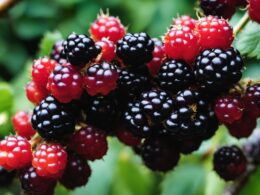Welcome to the world of home gardening! If you’ve ever wanted to grow your own tropical tree, learning how to grow a mango seed in water is a great place to start. Mango trees not only provide delicious fruits, but they also add a touch of exotic beauty to any garden or indoor space.
In this guide, we’ll walk you through the step-by-step process of growing a mango seed in water. It’s a fun and rewarding project that can be enjoyed by both beginners and experienced gardeners. So, let’s get started!
To begin, gather the necessary materials:
- A ripe mango
- A glass of water
- Kitchen scissors
- Paper towels
- A sandwich bag
- A medium-size pot
- Potting soil
Once you have everything ready, follow these simple steps:
- Cut open the mango and remove the seed
- Clean the seed husk
- Soak the seed in water for 24 hours
- Wrap the seed in a moist paper towel
- Place it in a sandwich bag
- Store it in a warm place
Now, all you have to do is monitor the seed for sprouts. Once you see the first signs of growth, transfer it to a pot with potting soil, making sure not to cover the new leaves. Within a week, your mango tree should start to grow, bringing a taste of the tropics to your home.
Stay tuned for more tips and advice on successful mango seed germination and best practices for growing mango trees. Happy gardening!
Tips for Successful Mango Seed Germination
When it comes to growing mango trees from seeds, there are several important factors to consider to ensure successful germination. Here are some valuable tips to guide you through the process:
- Check the Mango Seed Viability: Before proceeding with germination, examine the mango seed closely to ensure it is viable. Look for a plump, full-bodied seed with a firm texture. Avoid seeds that are shriveled, discolored, or damaged, as they may not germinate effectively.
- Choose the Drying Method or Soaking Method: There are two common methods to prepare the mango seed for germination: the drying method and the soaking method. The drying method involves placing the seed in a sunny and airy location for a few weeks. This allows the seed to dry out and prepares it for germination. Alternatively, you can opt for the soaking method, which entails scarifying the seed by gently nicking the outer husk and then soaking it in water for 24 hours. Both methods can yield successful results, so choose the one that suits your preference and available resources.
- Sun Harden the Seedling: After the seed has germinated and sprouted, it’s important to gradually expose the seedling to sunlight. This process, known as sun hardening, helps the young plant adjust to the intensity of direct sunlight. Start by placing the seedling in a partially shaded area, gradually increasing sun exposure over a period of several days or weeks. Sun hardening strengthens the seedling and prepares it for transplantation.
- Transplanting the Seedling: Once the seedling has grown to a suitable size and has been adequately sun hardened, it is ready to be transplanted. Choose a location with full sun, ensuring that the soil is well-draining and rich in organic matter. If you live in an area with cooler weather or limited space, you can keep the seedling in a container. This allows for easy movement and protection during unfavorable conditions.
By following these tips, you can significantly increase the chances of successful mango seed germination. Remember to be patient and provide the necessary care and attention as your mango tree grows from a tiny seedling into a majestic tropical tree.
Best Practices for Growing Mango Trees
When it comes to growing mango trees, there are a few essential practices that can help ensure success. First and foremost, consider the climate suitability for mango cultivation. Ideally, you want to grow mango trees in USDA hardiness zones 9B or above. This will provide the optimal conditions for your tree to thrive and produce delicious fruits.
If possible, try to find a parent mango tree in your area. The parent tree will serve as a good indicator of the suitability of your climate for mango cultivation. By ensuring that the seed comes from a tree that is already thriving in your specific conditions, you increase the chances of success for your own mango tree.
Proper watering and fertilization are crucial for the healthy growth of a mango tree. Water your tree regularly, but be careful not to overwater as this can lead to root rot. It’s important to find the right balance to keep the soil moist without causing waterlogging. Additionally, fertilize your mango tree sparingly to avoid excessive leaf growth. Too much fertilizer can hinder fruit production.
Lastly, it’s important to have patience when growing mango trees. Unlike some other fruit trees, mango trees can take several years to bear fruit. It’s not unusual for mango trees to take five to eight years after planting before they start producing fruits. So, be patient and enjoy the process of nurturing your tree as it grows into a mature and fruitful plant.
Can the Water Growing Method for Mango Seeds be Applied to Hydrangeas in a Pot?
Yes, the water growing method for mango seeds can be applied to caring for potted hydrangeas. Simply place the hydrangea cutting in a jar of water until roots form, then transfer it into a pot with well-draining soil. Proper watering and light are crucial for caring for potted hydrangeas.










